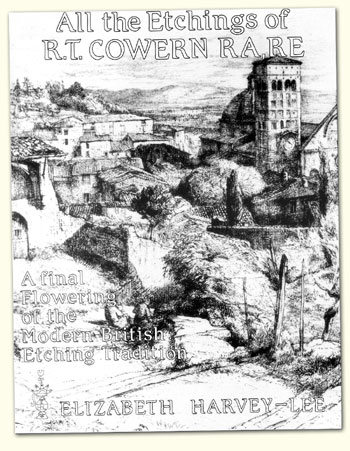|
All
the Etchings of R T COWERN RA,
RE
 A
final flowering of the Modern British Etching Tradition
1930-1940, seen in the works of Cowern, his teachers,
his friends & fellow students
at sequentially Birmingham School of Art, the Royal College of Art, London and
at the British School at Rome. A
final flowering of the Modern British Etching Tradition
1930-1940, seen in the works of Cowern, his teachers,
his friends & fellow students
at sequentially Birmingham School of Art, the Royal College of Art, London and
at the British School at Rome.
Both
a catalogue raisonné of the etchings of
R T Cowern and a portrait of a decade of etching production
and education in a small close-knit group.
Cowern entered Birmingham Art School in 1929 and won
a scholarship to the Engraving School of the Royal College
of Art in 1931. His etching activity began just as the
etching market had crashed after the boom years of the
twenties. He effectively stopped etching in 1940 when
the War diverted his efforts. He did not resume after
the War when the commitments of a young family were best
met in the security of a teaching post. Though in the
Etching Room at Brighton School of Art he passed on his
love of the technique, etching was generally in abeyance
in post-war printmaking for nearly twenty years.
The
decade of the 1930’s is self-contained, beginning
with the Crash and ending in the clash of World War Two.
Despite the epithet of the ‘Etching Boom’,
in intaglio printmaking in the 1920’s drypoint
had predominated over etching and in the second half
of the decade there had been a revival of interest in
original line engraving. The new generation of the 1930’s
concentrated mainly on traditional etching. Cowern described
it as an "absolute compulsion to etch".
Cowern’s
first teacher, Noel Spencer at Birmingham was an etcher,
but at the Royal College Malcolm Osborne at this period
worked mainly in drypoint and Robert Austin used line
engraving.
There
is a consistent quality to Cowern’s
work and that of his peers which immediately places it
in the ethos and milieu of the R.C.A. and the graphic
tradition that had developed there through the preceding
decades. General
art training at the R.C.A., as at provincial art schools
such as Birmingham, was grounded in drawing. Cowern
and his fellow students, like their teachers, were
primarily draughtsmen. They did not share the painterly
concerns which were to preoccupy post-war printmaking
or the ‘modernist’ ideas of other ’30’s
trends such as the vogue for the colour linocut at the
Grosvenor School.
Cowern’s earliest plates show the direct influence
of his teachers but in 1932/33 he discovered the advantages
of working directly on the plate out of doors and produced
sensitive and individual airy landscapes and tree studies
on Putney Heath and Wimbledon Common and developed his
own delicate broken line. The various demands of the
impending Diploma led to figure compositions in 1934,
bathed in interior sunlight through curtains. Draughtsman
to the Sakkharah expedition in 1935 there followed atmospheric
plates of palm trees and the landscape at Memphis, Egypt.
The culmination was in the Italian landscape plates,
such as his masterpiece “Anticoli Corrado below
the Waterfall”, as a Rome Scholar 1937-39.
Cowern
was an exact contemporary student at the Royal College
of Murray M Tod, Wilfred Fairclough, Martyn Lack, Denise
Brown, Eric Taylor and R Stanley Dent; a remarkable
group who all received early recognition in the pages
of 'Fine Prints of the Year' and in early election,
while still students, to the Royal Society of Painter-Etchers.
(At a period when etching was being abandoned and new
recruits must have been very welcome.) Fairclough went
on to win the Prix de Rome (1934-37), followed by Tod
(1935-38) and Cowern (1937-39). Taylor and Dent were
runners up. H Andrew Freeth, Cowern’s close friend
from Birmingham Art School, preceded Cowern to Rome,
winning his scholarship unprecedently directly from Birmingham
rather than a London postgraduate college (1936-39).
They were a close group of friends and their work is
interrelated yet individual; it has a period charm but
at its best produced timeless minor masterpieces.
Published 1996
140 pages, 159 items described and illustrated.
(UK
Price: £25, International orders: £30)
I
generally have some etchings by Cowern available in
current stock. These are soon to be included
as a small Exhibition in the Web
Exhibitions section of the website.
^ Return to the top of this page ^
|